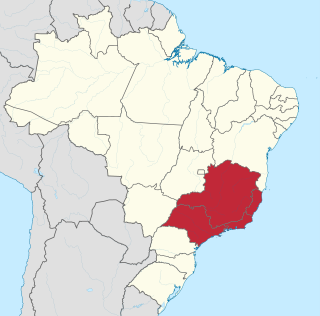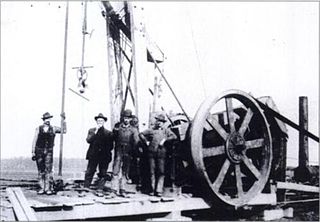
Latin America is the portion of the Americas comprising countries and regions where Romance languages—languages that derived from Latin—such as Spanish, French and Portuguese are predominantly spoken. The term is used for those places once ruled under the Spanish, French, and Portuguese empires. Parts of the United States where Romance languages are primarily spoken are not usually included due to the country as a whole being a part of Anglo-America,. The term is broader than categories such as Hispanic America, which specifically refers to Spanish-speaking countries; and Ibero-America, which specifically refers to both Spanish and Portuguese-speaking countries. The term is also more recent in origin.

Phelps Dodge Corporation was an American mining company founded in 1834 as an import-export firm by Anson Greene Phelps and his two sons-in-law William Earle Dodge, Sr. and Daniel James. The latter two ran Phelps, James & Co., the part of the organization based in Liverpool, England. The import-export firm at first exported United States cotton from the Deep South to England, and imported various metals to the US needed for industrialization. With the expansion of the western frontier in North America, the corporation acquired mines and mining companies, including the Copper Queen Mine in Arizona and the Dawson, New Mexico coal mines. It operated its own mines and acquired railroads to carry its products. By the late 19th century, it was known as a mining company.

AGC Inc., formerly Asahi Glass Co., Ltd.'(旭硝子株式会社), is a Japanese global glass manufacturing company, headquartered in Tokyo. It is the largest glass company in the world and one of the core Mitsubishi companies.

The Northwestern Hawaiian Islands or Leeward Islands are the small islands and atolls in the Hawaiian island chain located northwest of the islands of Kauai and Niihau. Politically, they are all part of Honolulu County in the U.S. state of Hawaii, except Midway Atoll, which is a territory distinct from the State of Hawaii, and grouped as one of the United States Minor Outlying Islands. The United States Census Bureau defines this area, except Midway, as Census Tract 114.98 of Honolulu County. Its total land area is 3.1075 square miles (8.048 km2). All the islands except Nihoa are north of the Tropic of Cancer, making them the only islands in Hawaii that lie outside the tropics.

PPG Industries, Inc. is an American Fortune 500 company and global supplier of paints, coatings, and specialty materials. With headquarters in Pittsburgh, Pennsylvania, PPG operates in more than 70 countries around the globe. By revenue it is the largest coatings company in the world followed by AkzoNobel. It is headquartered in PPG Place, an office and retail complex in downtown Pittsburgh, and is known for its glass facade designed by Philip Johnson.

O-I Glass, Inc. is an American Fortune 500 company that specializes in container glass products. It is one of the world's leading manufacturers of packaging products, holding the position of largest manufacturer of glass containers in North America, South America, Asia-Pacific and Europe. Approximately one of every two glass containers made worldwide is made by O-I, its affiliates, or its licensees.

CEMEX S.A.B. de C.V., known as Cemex, is a Mexican multinational building materials company headquartered in San Pedro, near Monterrey, Mexico. It manufactures and distributes cement, ready-mix concrete and aggregates in more than 50 countries. In 2020 it was ranked as the 5th building materials company in the world.

Christmas ornaments, baubles, "christmas bulbs" or "Christmas bubbles" are decoration items, usually to decorate Christmas trees. These decorations may be weaved, blown, molded, carved from wood or expanded polystyrene, or made by other techniques.

The Southeast Region of Brazil is composed of the states of Espírito Santo, Minas Gerais, Rio de Janeiro and São Paulo. It is the richest region of the country, responsible for approximately 60% of the Brazilian GDP, as São Paulo, Rio de Janeiro, and Minas Gerais are the three richest states of Brazil, the top three Brazilian states in terms of GDP. The Southeast of Brazil also has the highest GDP per capita among all Brazilian regions.

San Nicolás de los Garza, sometimes known only as San Nicolás, is a city and coextensive municipality in the Mexican state of Nuevo León that is part of the Monterrey metropolitan area. It has become primarily a city for residences and family houses, although it still has several factories that tend to relocate to the periphery of the metropolitan area. It is the third-largest city in the state, behind Monterrey and Guadalupe.

Ball Corporation is an American company headquartered in Broomfield, Colorado. It is best known for its early production of glass jars, lids, and related products used for home canning. Since its founding in Buffalo, New York, in 1880, when it was known as the Wooden Jacket Can Company, the Ball company has expanded and diversified into other business ventures, including aerospace technology. It eventually became the world's largest manufacturer of recyclable metal beverage and food containers.
Goldcorp Inc. was a gold production company headquartered in Vancouver, British Columbia, Canada. The company employed about 15,800 people worldwide, engaged in gold mining and related activities including exploration, extraction, processing and reclamation. Goldcorp’s operating assets included four mines in Canada, two mines in Mexico, and four in Central and South America. As of the third quarter of 2014, Goldcorp was the world's fourth-largest producer of gold. On January 14, 2019, Goldcorp agreed to a merger acquisition by Newmont Mining Corporation, the world’s second-largest producer of gold, with the merged “Newmont Goldcorp” to be the world’s largest producer.
Heineken Lager Beer, or simply Heineken is a pale lager beer with 5% alcohol by volume produced by the Dutch brewing company Heineken N.V.. Heineken beer is sold in a green bottle with a red star.

San Juan de Los Cerritos, commonly known as Cerritos, is a city located in the central part of San Luis Potosí, a state of Mexico. It was founded in 1826 by the state's Congress. It is within the mid-zone of the state called La Zona Media. Within its municipality, which is the center of, it holds about 51 other small towns. According to the 2010 census, the municipality has 21,394 people; having experienced tremendous growth. Much of its recent growth can be credited to the construction of the cement factory, Cemento Moctezuma, An industry that was dominated by Casa Gloria During the decades of the 1960s and 1970s. Nowadays Cerritos is expanding its population and more housing is being built near the outskirts of the city due to the influx of new residents.

Gruma, S.A.B. de C.V., known as Gruma, is a Mexican multinational corn flour (masa) and tortilla manufacturing company headquartered in San Pedro, near Monterrey, Nuevo León, Mexico. It is the largest corn flour and tortilla manufacturer in the world. Its brand names include Mission Foods, Maseca, and Guerrero.
Mining in Brazil is centered on the extraction of iron, copper, gold, aluminum, manganese, tin, niobium, and nickel. About gemstones, Brazil is the world's largest producer of amethyst, topaz, agate and is a big producer of tourmaline, emerald, aquamarine, garnet and opal.

Tomatin distillery is a single malt Scotch whisky distillery in the village of Tomatin. Its whisky is classified as being from the Highland region, as it is 25 minutes south of Inverness.

The Indiana gas boom was a period of active drilling and production of natural gas in the Trenton Gas Field, in the US state of Indiana and the adjacent northwest part of Ohio. The boom began in the early 1880s and lasted into the early 20th century.
This article provides an overview of the automotive industry in countries around the world.

Agriculture in Mexico has been an important sector of the country’s economy historically and politically even though it now accounts for a very small percentage of Mexico’s GDP. Mexico is one of the cradles of agriculture with the Mesoamericans developing domesticated plants such as maize, beans, tomatoes, squash, cotton, vanilla, avocados, cacao, various kinds of spices, and more. Domestic turkeys and Muscovy ducks were the only domesticated fowl in the pre-Hispanic period and small dogs were raised for food. There were no large domesticated animals.
















